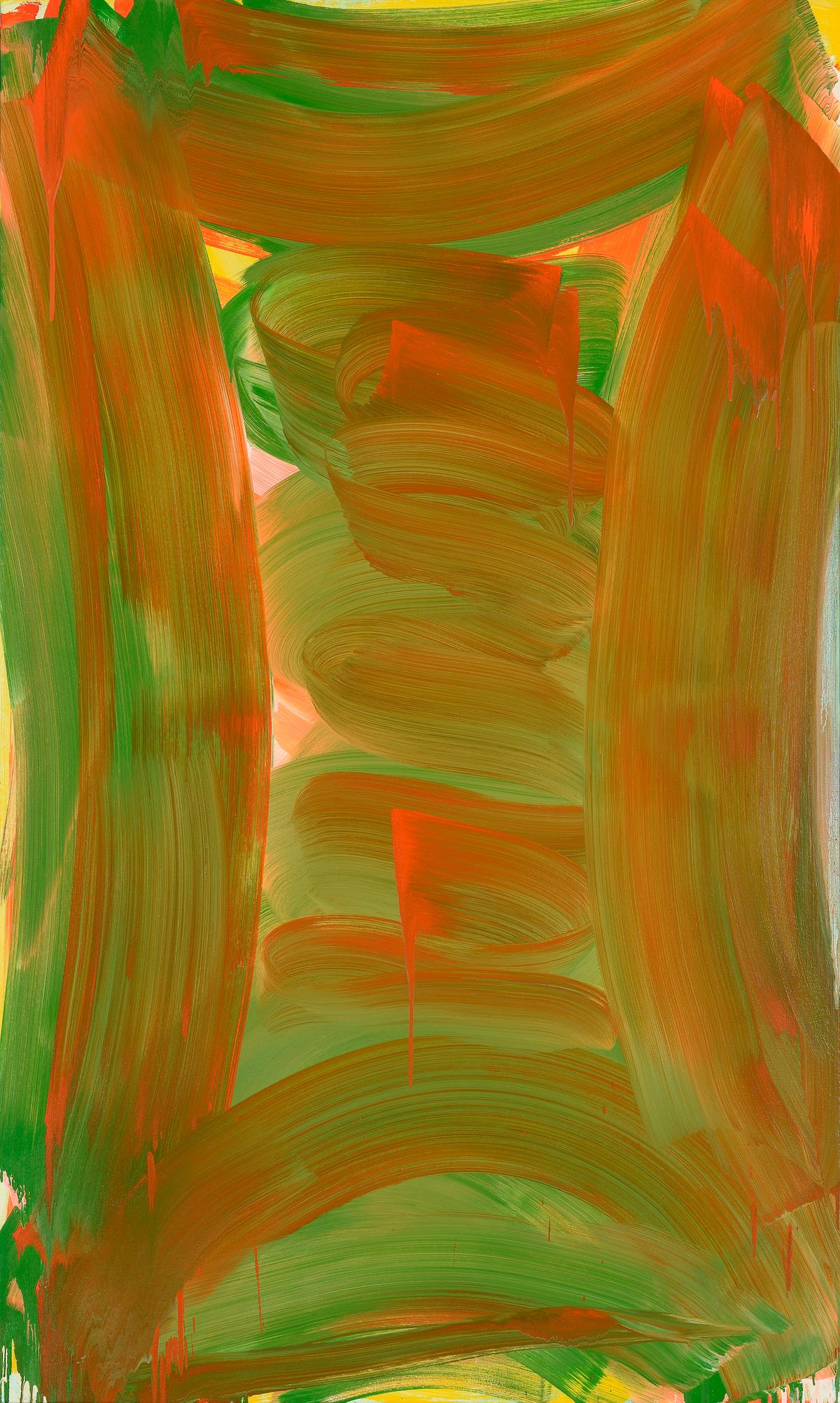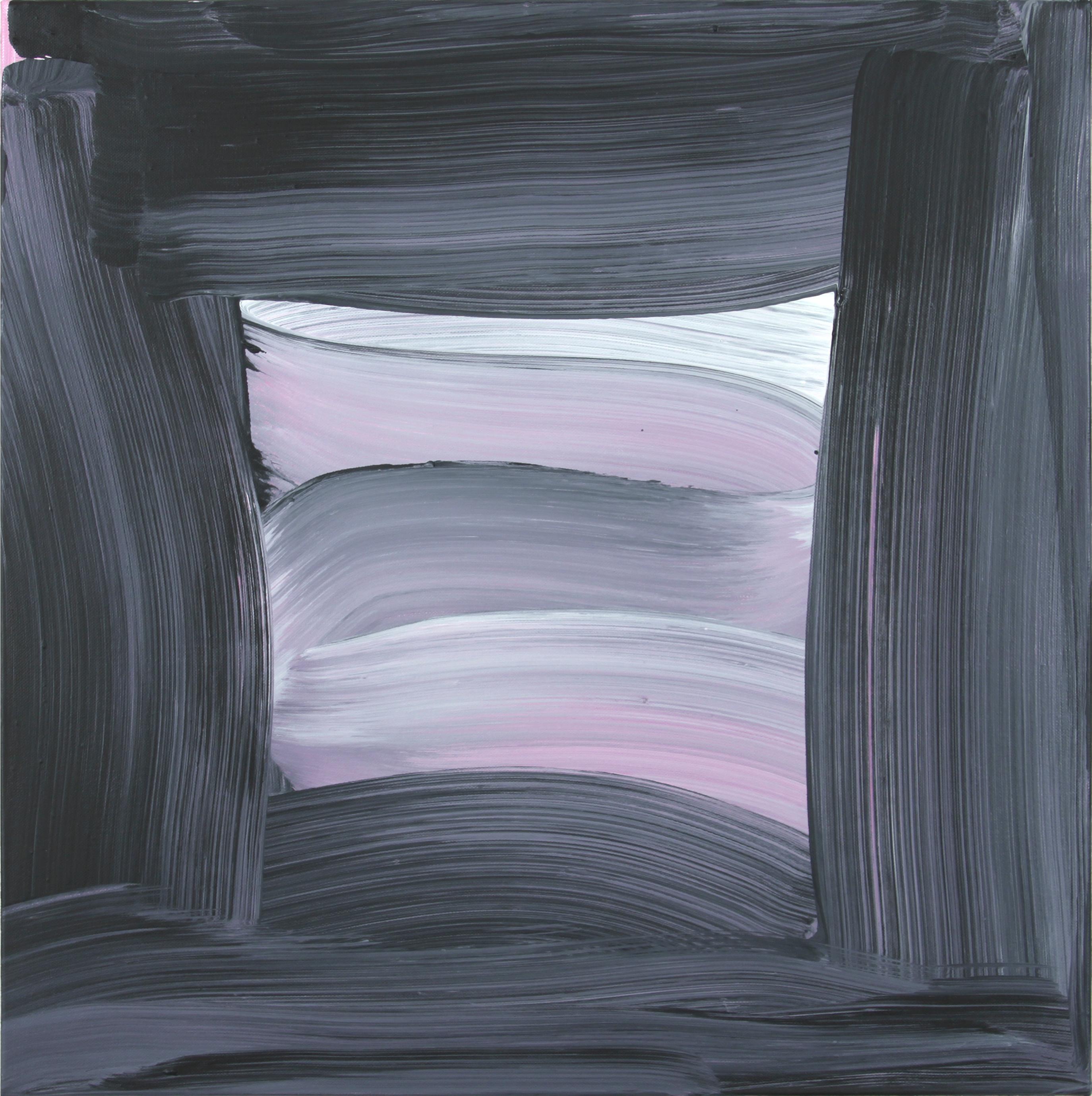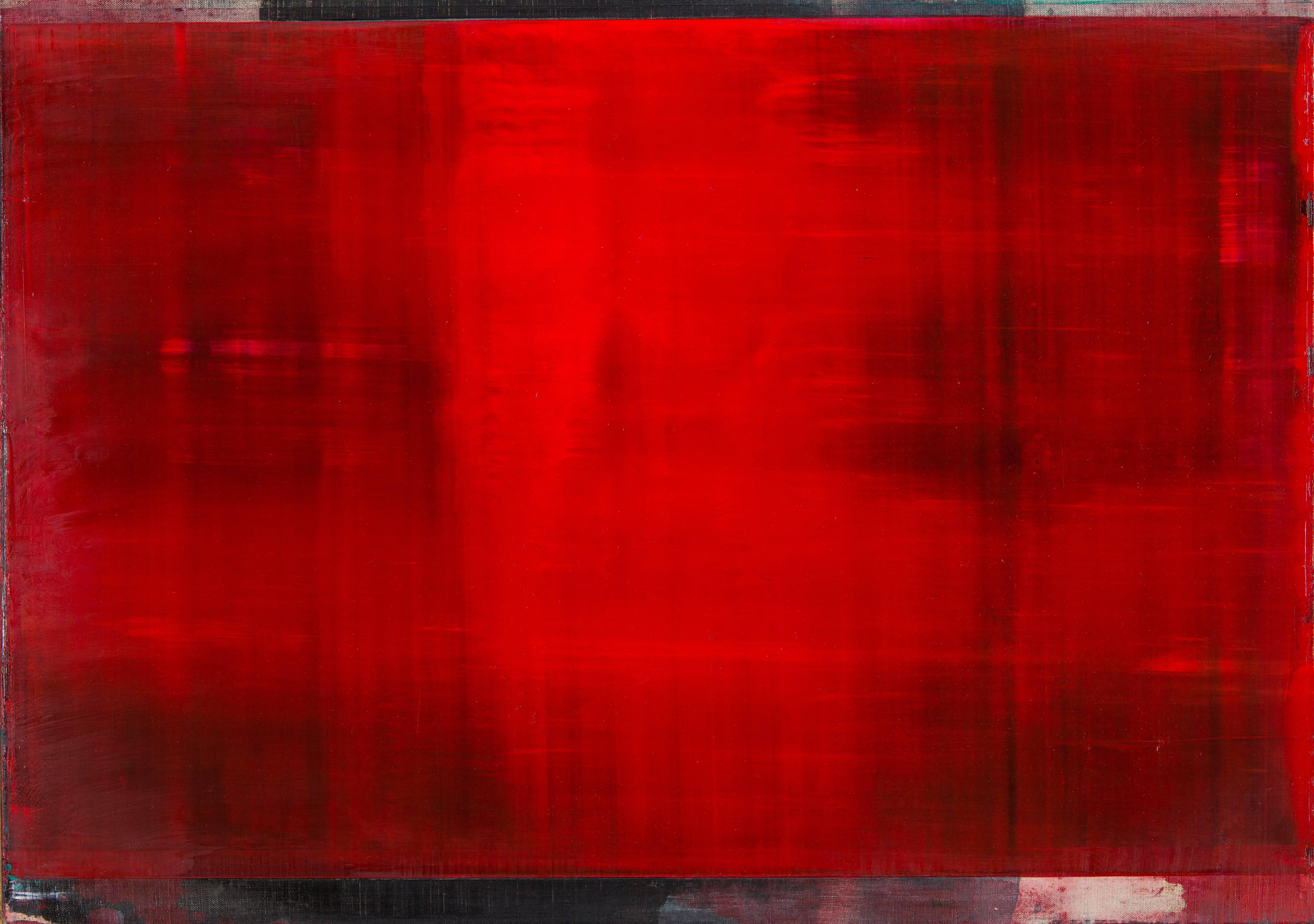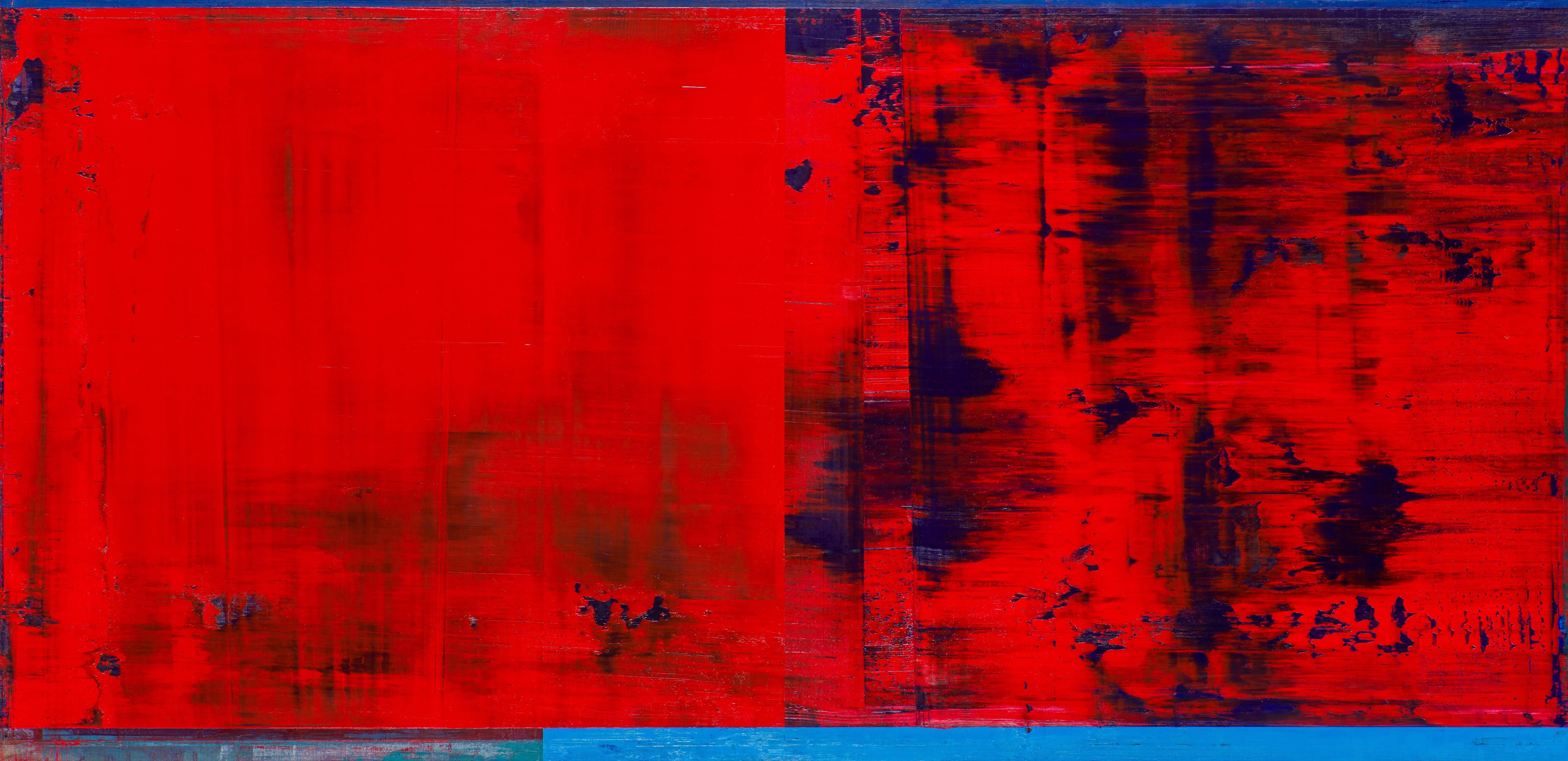Items Similar to Mid Century Textural Color-Field Abstract in Royal Blue-Purple by Peter Witwer
Want more images or videos?
Request additional images or videos from the seller
1 of 12
Peter WitwerMid Century Textural Color-Field Abstract in Royal Blue-Purple by Peter Witwerc.1960s
c.1960s
About the Item
Mid Century Textural Color-Field Abstract in Royal Blue-Purple by Peter Witwer
A striking mid-century textural color-field abstract in a bold color palette of royal blue-purple by San Francisco artist Peter Witwer (American, 1928-1968). This highly textured mixed media piece, c.1960's, uses a monochromatic palette that is divided into two areas of varying textural depths. The lower part of the canvas verges on sculptural, as the textured surface becomes almost three-dimensional and haunting forms emerge from the abstract purple-blue plane.
Unsigned. From a collection of the artist's works.
Displayed in a painted wood slate frame. Frame has been painted by the artist and is considered part of the artwork.
Linen size: 26"H x 22"W.
Framed size: 27"H x 23"W x 1.2"D
Unsigned, but was acquired with a collection of the artist's work.
Provenance: Without a will and a family that had little interest in his art, nearly all of his possessions and close to 100 paintings were turned over to SF’s Conservators Office. His friend, Albert Richard Lasker, purchased all of Peter’s possessions (including the art) and has taken care of them until this day, always sensing there was something remarkable about the collection. Wanting Peter’s work to finally be seen, Richard came to Lost Art Salon with Peter’s story after reading about the new gallery in a July, 2005 issue of the SF Chronicle.
Born George Peter Witwer on September 6th, 1928, Peter was the son of a prominent real estate developer in Cedar Rapids, Iowa. He attended school in New York City in the late 1940s and moved West in 1958. Part of San Francisco’s emerging gay scene, Witwer was walking home from the original Stud Bar on Folsom Street when he was brutally shot in the head without an apparent motive in 1968. The police report shows that the cash in his pocket was not removed, leading friends to believe that this may have been a hate crime.
While living in New York from 1945-1958, Witwer was a contemporary of Jackson Pollock, Willem de Kooning and Hans Hoffman and witnessed their massive influence on Post WWII painting first hand. Shortly after Witwer’s arrival to San Francisco in 1958, he exhibited alongside David Park and Elmer Bischoff in the 1959 California Painters’ Annual at the Oakland Art Museum, where the first exhibition of Bay Area Figurative painting took place in 1957. The 1957 show, entitled “Contemporary Bay Area Figurative Painting” also included seminal works by Richard Diebenkorn, James Weeks, Bruce McGaw and Paul Wonner.
Peter Witwer would never achieve the recognition of the aforementioned artists. In fact, he spent his life in relative obscurity, working during the day at the Rincon Post Office and City of Paris department store, and painting at night in the studio of his apartment on Waller Street in the Haight. In spite of this, his recently uncovered body of work brilliantly reflects two of the most important art movements of the last 60 years. The collection showcases a newly-discovered artist working on the leading edge of contemporary painting during his time.
Within the Witwer collection, several distinct art movements can be seen. Works from 1961-1963 period show a strong tendency towards the New York school of Abstract Expressionism (Hans Hoffman, Jackson Pollock and others). Highly textured Colour-Field pieces from this early 60s period also reflect the influence of the European Decollage artists that tore into built-up surfaces to reveal the shreds of paper below. Witwer experimented with plaster-like compounds for sculpting under the surface of paintings; house paints; textile and found object collage; and large-scale canvases. As his work progressed through the 1960s, the paintings take-on distinct qualities of the Bay Area Figurative movement. These works merge the human form with painterly abstraction, drawing strong comparisons to the art of his contemporaries, David Park, Elmer Bischoff, Manuel Neri and Nathan Oliveira.
In the Fall of 1968 Peter Witwer was shot dead as he walked home through his Haight Ashbury neighborhood. Since then, his life’s work of nearly a hundred finished paintings has been in hiding for four decades. Reflecting the dynamic evolution of American Mid-Century painting from the Abstract Expressionism of the 1940s/50s into the Bay Area Figurative movement of the 1950s/60s Witwer’s work is a spectacular timeline of the Bay Area art scene.
Lost Art Salon Biography from the one man show:
In the Fall of 1968 Peter Witwer was shot dead as he walked home through his Haight Ashbury neighborhood. Since then, his life’s work of nearly a hundred finished paintings has been in hiding for four decades. Reflecting the dynamic evolution of American Mid-Century painting from the Abstract Expressionism of the 1940s/50s into the Bay Area Figurative movement of the 1950s/60s, the Witwer collection is a spectacular timeline of the Bay Area art scene. Lost Art Salon will host Peter Witwer’s first ever one-man, showcasing his work and personal story.
While living in New York from 1945-1958, Witwer was a contemporary of Jackson Pollock, Willem de Kooning and Hans Hoffman and witnessed their massive influence on Post WWII painting first hand. Shortly after Witwer’s arrival to San Francisco in 1958, he exhibited alongside David Park and Elmer Bischoff in the 1959 California Painters’ Annual at the Oakland Art Museum, where the first exhibition of Bay Area Figurative painting took place in 1957. The 1957 show, entitled “Contemporary Bay Area Figurative Painting” also included seminal works by Richard Diebenkorn, James Weeks, Bruce McGaw and Paul Wonner.
Peter Witwer would never achieve the recognition of the aforementioned artists. In fact, he spent his life in relative obscurity, working during the day at the Rincon Post Office and City of Paris department store, and painting at night in the studio of his apartment on Waller Street in the Haight. In spite of this, his recently uncovered body of work brilliantly reflects two of the most important art movements of the last 60 years. The collection showcases a newly-discovered artist working on the leading edge of contemporary painting during his time.
Within the Witwer collection, several distinct art movements can be seen. Works from 1961-1963 period show a strong tendency towards the New York school of Abstract Expressionism (Hans Hoffman, Jackson Pollock and others). Highly textured Colour-Field pieces from this early 60s period also reflect the influence of the European Decollage artists that tore into built-up surfaces to reveal the shreds of paper below. Witwer experimented with plaster-like compounds for sculpting under the surface of paintings; house paints; textile and found object collage; and large-scale canvases. As his work progressed through the 1960s, the paintings take-on distinct qualities of the Bay Area Figurative movement. These works merge the human form with painterly abstraction, drawing strong comparisons to the art of his contemporaries, David Park, Elmer Bischoff, Manuel Neri and Nathan Oliveira.
Born George Peter Witwer on September 6th, 1928, Peter was the son of a prominent real estate developer in Cedar Rapids, Iowa. He attended school in New York City in the late 1940s and moved West in 1958. Part of San Francisco’s emerging gay scene, Witwer was walking home from the original Stud Bar on Folsom Street when he was brutally shot in the head without an apparent motive. The police report shows that the cash in his pocket was not removed, leading friends to believe that this may have been a hate crime.
- Creator:Peter Witwer (1928 - 1968)
- Creation Year:c.1960s
- Dimensions:Height: 27 in (68.58 cm)Width: 23 in (58.42 cm)Depth: 1.2 in (3.05 cm)
- Medium:
- Movement & Style:
- Period:
- Condition:Cracquelure to medium on lower half has been in-painted and restored. Vintage frame has been painted by the artist and is considered part of the artwork.
- Gallery Location:Soquel, CA
- Reference Number:
About the Seller
5.0
Platinum Seller
These expertly vetted sellers are 1stDibs' most experienced sellers and are rated highest by our customers.
Established in 1986
1stDibs seller since 2014
2,513 sales on 1stDibs
Typical response time: <1 hour
- ShippingRetrieving quote...Ships From: Soquel, CA
- Return PolicyA return for this item may be initiated within 14 days of delivery.
More From This SellerView All
- Bold Colorfield AbstractBy Martin AguilarLocated in Soquel, CAA bright and bold colorfield abstract by Martin Aguilar (American, 20th Century). Signed monogram signature on verso. Image size, 24"H x 18"W. Unframed. Growing up in New Mexico’s b...Category
Early 2000s Color-Field Abstract Paintings
MaterialsCanvas, Oil
- Contemporary Abstract Colorfield Landscape in Cream & GreenBy Michael PaukerLocated in Soquel, CAA striking contemporary two-toned colorfield abstract by Bay Area artist Michael Pauker (American, b. 1957). A large neutral textured section in cream sits atop a wavy abstraction in...Category
21st Century and Contemporary Color-Field Abstract Paintings
MaterialsCanvas, Oil
- Small Abstracted Color Field Painting -- MatchsticksBy Michael PaukerLocated in Soquel, CAColorful abstracted color field painting of matchsticks by Bay Area artist Michael Pauker (American, b. 1957), circa 2000. Unsigned, but was acqui...Category
21st Century and Contemporary Color-Field Abstract Paintings
MaterialsGlass, Plastic, Wood, Paper, Oil
- "Moulin Rouge", Contemporary Aquamarine & Grey Two-Toned Colorfield AbstractBy Michael PaukerLocated in Soquel, CAStriking abstract colorfield oil painting on wood panel by Michael Pauker (American, b. 1957). This uniquely textured two-toned abstract is divided into color-fields of super vivid a...Category
21st Century and Contemporary Color-Field Abstract Paintings
MaterialsWood Panel, Oil
- "Red Sea, Two Moons" - Large Scale Minimalist Horizontal Color Field AbstractBy Sasha RogersLocated in Soquel, CALarge-scale abstract minimalist color field painting titled, "Red Sea, Two Moons" by Canadian abstract painter Sasha Rogers (Canadian, b. 19...Category
1990s Color-Field Abstract Paintings
MaterialsCanvas, Acrylic
- "Open Window", Large Scale Minimalist Color-Field AbstractBy Sasha RogersLocated in Soquel, CALarge scale, compelling abstract titled "Open Window" by Canadian abstract painter Sasha Rogers (Canadian, b. 1969), daughter of premier art...Category
1980s Color-Field Abstract Paintings
MaterialsCanvas, Acrylic
You May Also Like
- Anne Russinof, Tall Vault 2015, Oil on canvas, Color Field, AbstractionBy Anne RussinofLocated in Darien, CTRussinof uses large brushes to create highly energized gestures that intimate various patterns and forms in architecture such as frames, cornices and baroque ceiling vaults. The paint-ings are process-based in the sense that one is aware of drips and the accretion of layers, and also flirt with their role as objects by virtue of the gesture’s relation to the painting edge. Color serves to create a window onto natural space and light, even as the forms themselves acknowledge their own framing. She often thinks in these works of Renaissance portraits where the sitter’s forearm rests on the very edge of the frame, inviting intimacy, with a tiny landscape...Category
2010s Color-Field Abstract Paintings
MaterialsLinen, Oil
- Anne Russinof, Pearly Frame, 2015, Oil on canvas, Color Field, AbstractionBy Anne RussinofLocated in Darien, CTRussinof uses large brushes to create highly energized gestures that intimate various patterns and forms in architecture such as frames, cornices and baroque ceiling...Category
2010s Color-Field Abstract Paintings
MaterialsOil, Linen
- OX 78By Daniel BriceLocated in Phoenix, AZoil and acrylic on linen over panel In his abstract paintings and prints, Daniel Brice explores both the physicality and the intellectual and emotional resonance of color. Based in ...Category
2010s Color-Field Paintings
MaterialsOil, Acrylic, Panel, Wood Panel, Linen
- OX 79By Daniel BriceLocated in Phoenix, AZoil and acrylic on linen over panel In his abstract paintings and prints, Daniel Brice explores both the physicality and the intellectual and emotional resonance of color. Based in...Category
2010s Color-Field Paintings
MaterialsLinen, Oil, Acrylic, Panel, Wood Panel
- OX 70By Daniel BriceLocated in Phoenix, AZoil and acrylic on linen over stretcher bars In his abstract paintings and prints, Daniel Brice explores both the physicality and the intellectual and emotional resonance of color. ...Category
2010s Color-Field Paintings
MaterialsLinen, Oil, Acrylic, Stretcher Bars
- OX 67By Daniel BriceLocated in Phoenix, AZoil and acrylic on linen over panel In his abstract paintings and prints, Daniel Brice explores both the physicality and the intellectual and emotional resonance of color. Based in ...Category
2010s Color-Field Paintings
MaterialsPanel, Wood Panel, Linen, Oil, Acrylic
Recently Viewed
View AllMore Ways To Browse
Midcentury Abstract Painting
American Midcentury Painting
Color Field Abstract
Mid Century Purple
House In Field
W Field
Retro Palette Color
Mid Century Abstract Large
S Field Artist
Royal Interest
Royal Vintage Frames
American Color Field Painting
American Midcentury Oil Painting
Large Color Field Paintings
Vintage Linen Color
Mid Century Abstract Art Large
Home From The Fields
Blue Peter





